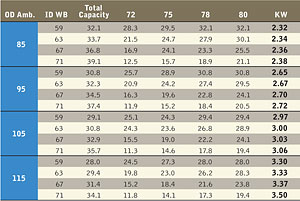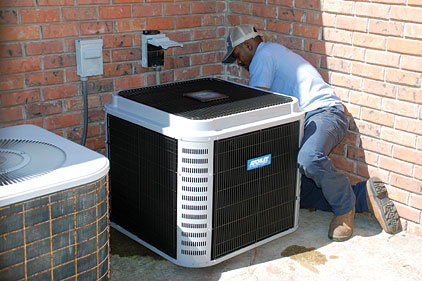We all know anyone quoting a new heating and cooling system should always perform a load calculation on the structure. I’m sure 95 percent of us do, right?

|
| Trane XR15 performance table. |
After entering all the variables with a reasonable degree of accuracy, the software generates a report that gives the user a total heating-cooling load on the structure. Then we can recommend the proper-size unit that is neither too large nor too small for the structure.
Cooling Loads
On the cooling side, loads are broken out into total cooling required, sensible load, latent load, and sensible/latent ratios. The sensible cooling load reflects the actual temperature difference between indoor and outdoor design conditions, along with solar loads. The latent, or hidden, cooling load reflects the dehumidification load on the structure. It’s important to remember that most cooling coils are designed to do approximately 75 percent of their work in the form of sensible cooling, and 25 percent of their work in the form of latent cooling. Most load calculation programs generate a report showing total cooling required, in Btu per hour, and the recommended cooling required, so we can meet both sensible and latent cooling loads.
Once you know the total cooling load on the structure, you can pick an air conditioner and cooling coil combination that will meet both loads. Here in Illinois, we design for 75˚F indoor dry bulb at 50 percent relative humidity; a wetbulb temperature of 62.54˚; and an outdoor temperature of 95˚.
Manufacturer Specs
If you look at the manufacturer’s performance specs on an air conditioning unit, you will find the performance is rated at 80˚ indoor dry bulb at 51 percent relative humidity, 67˚ wet bulb and 95˚ outdoor ambient. It’s important to realize that at an indoor spec of 75˚ dry bulb and 50 percent relative humidity the wet bulb temperature is 62.54˚, not 67˚.
Looking at the performance table of a Trane XR15, 15-SEER, 3-ton cooling unit (Figure 1) with a variable-speed furnace and matched coil, you can see that at 75˚ indoor dry bulb, 63˚ indoor wet bulb (50-percent RH), and 95˚ outdoor ambient, the actual cooling capacity of a nominal 3-ton unit is 32,300 Btuh, or 2.70 tons. Also note that the sensible vs. latent cooling ratios are 75 percent sensible (24.2/32.3 = 75 percent), 25 percent latent.
As you can see, if the cooling load on the structure is at or slightly over 3 tons, you may need to go up to the next larger size unit to handle the actual load on the structure.
It’s important that we all become familiar with the manufacturer’s performance specs on the particular brand of HVAC equipment we install, along with knowing what the specs actually mean. We, as professionals, owe it to our customers to properly design, install, and set up their new systems in a responsible manner, so they get what they are paying for — wouldn’t you agree?
Publication date: 08/15/2011


Report Abusive Comment